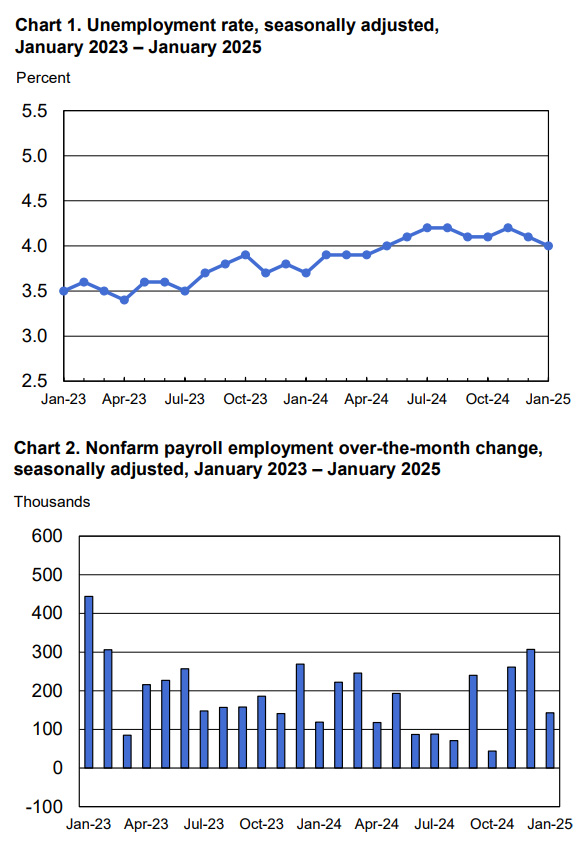 The first Bureau of Labor Statistics (BLS) Employment Situation Summary released after the Trump inauguration occurs in a noisy environment. Analysts had expected results to be weighed down by record cold weather over much of the country, job losses related to the California fires and perhaps buoyed by economic growth plans outlined by the new administration. Today’s results added some clarity to possible job market trends in the new year. Total nonfarm payroll employment increased by 143,000 in January, slightly below analysts’ estimates and similar to the average monthly gain of 166,000 in 2024. In a footnote, the BLS noted that the severe weather and California fires had ‘no discernable effect on national payroll employment.’ They also revised job growth up by a combined 100,000 for the November/December 2024 period.
The first Bureau of Labor Statistics (BLS) Employment Situation Summary released after the Trump inauguration occurs in a noisy environment. Analysts had expected results to be weighed down by record cold weather over much of the country, job losses related to the California fires and perhaps buoyed by economic growth plans outlined by the new administration. Today’s results added some clarity to possible job market trends in the new year. Total nonfarm payroll employment increased by 143,000 in January, slightly below analysts’ estimates and similar to the average monthly gain of 166,000 in 2024. In a footnote, the BLS noted that the severe weather and California fires had ‘no discernable effect on national payroll employment.’ They also revised job growth up by a combined 100,000 for the November/December 2024 period.
The unemployment rate edged down to 4.0 percent after accounting for the annual BLS update of U.S. population estimates. The number of unemployed people, at 6.8 million, changed little in January.
“The new administration in Washington is wasting no time in delivering on their campaign promises. Whether you agree or disagree with their programs, the speed, breadth and focus of implementation is impressive. Perhaps nothing illustrated their swift action as the decision to mandate an almost immediate return to office policy for most federal workers. Very few firms have demonstrated the same sense of urgency in making a definitive RTO decision in this critical issue that continues to roil the executive, technical, professional and managerial workplace that our HireQuest divisions of over 425 offices deal with every day,” noted Rick Hermanns, president and chief executive officer of HireQuest.
“The federal mandate, while disruptive to the status quo, provides a large-scale experiment on compliance and workplace impact for the private sector. The most recent Gallup Employee Engagement survey might indicate workplace fallout from the private sector, delaying decisions on this unresolved issue. Gallup reports that employee engagement has declined to a 10-year low, with only 31% of employees engaged. This matches the figure last seen in 2014. The percentage of actively disengaged employees, at 17%, also reflects 2014 levels. Among the 12 engagement elements measured in the survey, three elements had the most significant declines; ‘clarity of expectations,’ ‘feeling that my employer cares about me as a person,’ and ‘someone encourages my development.’
Every day our MRINetwork and Snelling professional talent advisors and executive recruiters work with clients to model possible RTO solutions. These include actively seeking employee feedback, ensuring clear communications to align RTO policy with the organizations’ core values, designing salary incentives and performance-based rewards for meeting or exceeding productivity targets, even addressing elements like transportation and child-care support. It is essential to promptly guide both candidates and managers to navigate the very real challenges to employee engagement and broader corporate culture standards within new RTO environments.”
Joseph Brusuelas, chief economist at RSM, provided a succinct overview of today’s report, “With inflation at least for now at tolerable levels and firms very comfortable making sustained investment, there’s no reason why we shouldn’t continue to see job growth around 150,000 per month, which is the upper end of what’s needed to keep the labor market stable. In other words, we’re at full employment. This is a good problem to have. The economy is still going to roll on, people are going to make investment decisions, they’re going to get up each morning and go to work.”
Echoing similar sentiments, Dan North, senior economist at Allianz Trade Americas noted, “There will be some noise, but the general message is going to be a continuation of a relatively healthy labor market. There’s no reason to derail that narrative.”
Key industries reported the following trends in January 2025:
Once again, the healthcare sector led in employment growth. Healthcare added 44,000 jobs in January, with gains in hospitals (+14,000), nursing and residential care facilities (+13,000), and home healthcare services (+11,000). Job growth in healthcare averaged 57,000 per month in 2024.
Employment in retail trade increased by 34,000 in January. Retail trade employment had shown little net change in 2024.
Social assistance added 22,000 jobs in January, in line with average growth of 20,000 per month in 2024. Government employment continued to trend up in January (+32,000), similar to the average monthly gain of 38,000 in 2024.
Continuing a trend noted throughout 2024, employment showed little change over the month in other major industries, including construction, manufacturing, wholesale trade, transportation and warehousing, information, financial activities, professional and business services, leisure and hospitality, and other services.
Employment in the mining, quarrying, and oil and gas extraction industry declined by 8,000 over the month, following little net change in 2024. In January, the job loss was concentrated in support activities for mining (-8,000).
“Our talent professionals advise C-level clients to move with a sense of urgency to implement final hybrid work and RTO polices early in the year. Firm and clearly communicated standards will allow management teams to define their workplace culture and align those cultural goals with onboarding, training and career development processes to build stronger bonds between employees and organizations regardless of workplace location,” noted Hermanns.

Connect with MRINetwork